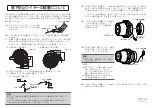
Ultrastar C handbook Issue 1, August 2015
A 430 second exposure of M16, using an FSQ106. No darks, flats or bias frames used.
Guiding with the Ultrastar C:
Although colour cameras are not ideal for guiding, they can still work very well. For guiding, the
Ultrastar C is generally used with a separate guide telescope, or via an off-axis guider assembly. It is
designed to be inserted into a standard 1.25” focuser tube, but also has a 25.4mm ‘C’ type camera lens
thread in the front to allow standard CCTV lenses or adaptors to be attached. Please note that the chip
to lens distance is only 12.5mm and so a ‘CS’ to ‘C’ extension will be needed to permit a standard C
lens to reach focus. Lenses designed for ‘CS’ mount cameras will focus without an extension tube, but
many of these lenses cannot fully illuminate a two thirds inch format CCD, so take care when selecting
a lens for this purpose.
A typical set up might consist of an inexpensive 80mm F5 refractor ‘piggybacked’ onto an SCT, with
the Ultrastar C fitted directly into its focus barrel. Many such telescopes are designed to be used with
an inverting prism ahead of the eyepiece and so the focuser may be too short when the Ultrastar C is
inserted directly. In this case, an extension tube may often be made from a cheap Barlow lens assembly
with the lens removed. This configuration can be seen in the picture below.
A guider attached to an 80mm F5 guide ‘scope






























